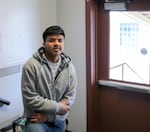Aspen Johnson is part of the roughly one-third of students at Madras High School who are Native American. She lives in Warm Springs about 20 miles from the high school.
She’s a bit sheepish about not graduating on time a year ago. Like lots of students in Oregon, she'd fallen behind on credits when she first got to Madras High.

Aspen Johnson finished up her high school diploma at Bridges, an alternative high school run by the Jefferson County School District, not far from Madras High.
Rob Manning / OPB
"You’re new to high school, you’re goofing around, thinking ‘Oh, these won’t count,’" Johnson said.
"But as a junior, it catches up with you, and then senior year it really impacts you and you’re thinking ‘Oh wow, I’m missing a couple of credits.'”
Nearly all the students at Madras High come from low-income families. According to recent research, that means they're more likely to fall behind academically.
The students who fell behind early in high school were less likely to be among the thousands of high school students earning Oregon diplomas this month. That failure lingers, as research shows dropouts tend to have worse job and health prospects and are more likely to end up in jail.
Oregon’s graduation rate has been slowly climbing in recent years, from 72 percent in 2014 to close to 77 percent a year ago. It's still among the worst in the country. At Madras High School, it's improving a lot more quickly.

Madras High School improved its graduation rate by more than twenty points in the last few years, to 78 percent - just above the Oregon average.
Rob Manning / OPB
In 2015, Madras High School had a 58 percent graduation rate — 14 points below Oregon's own lackluster average. That’s about when Mark Neffendorf and HD Weddel arrived as co-principals with a single focus.
“It’s all about graduation," Weddel said.
"We’re stubborn to that. We learn to say ‘no’ if it doesn’t have to do with the graduation rate.”
The state of Oregon has gotten tightly focused on students who are falling behind, as a key data point for high schools to follow. The "Freshmen On Track" metric is part of Oregon's plan that the U.S. Department of Education approved because it indicates whether a student is going to have a problem later on with graduation.
When Weddel arrived, he had few options for students who fall behind, like Johnson.
"I wouldn't say none ... there were very little," Weddel recalled.
Madras added a hands-on option through the nonprofit Heart of Oregon that Weddel characterizes as teaching students to build houses. Another program called Roots serves students miles away on the Warm Springs reservation, part of the high school's vast rural enrollment area.

HD Weddel is one of two principals at Madras High School, where graduation rates have improved thanks in part to a new alternative school nearby.
Rob Manning / OPB
When students are missing school, falling behind or facing other academic struggles, administrators lay out these options. Weddel tries to make it clear to students that just staying at the high school might not get them what they want.
"Did you say you want to graduate? And did you want to graduate on time?" Weddel said. "It puts them making the decision, not us."
Madras High added one more option recently: Bridges — an alternative high school serving about 150 students just downhill from Madras High.
Johnson shifted over to Bridges this school year. She appreciated that teachers seemed more accessible at Bridges and pulled in fewer different directions than at the main high school.
"For me, it's like I need help too, but there's like 20 other people wanting the teacher's attention," she recalled from her years at the main high school.
"Over here, it's like one-on-one, they can come to you, you don't have to compete for the teacher's attention," she said.
The focus on Bridges is on catching students up — through more individualized support. It offers online courses, which also allows Bridges to be more flexible for students who work, live far away or might face instability at home, including homelessness.

Vicente is a junior at the Bridges high school program in Madras, where he takes classes in person and online.
Rob Manning / OPB
One student named Vicente says that flexibility allows him to travel regularly to see his family. He's among another one-third of Madras students who are Latino.
"I've been going to Mexico and then I come back — I visit my parents and come back," said Vicente.
"If I want to go, and have a break, it's fine — anyways, I'm doing my class online."
Vicente seems to appreciate the close relationships at the school, too. As he walked up the main hall at Bridges on a recent spring afternoon, he made a point of telling Brian Crook, one of the school administrators, that he'd gotten his driver's permit.
"I passed the test," Vicente said with a grin.
"You did? Yes!" Crook responded, before telling him to start getting ready to get his license.
Crook works at both Madras High and Bridges. He says one thing Bridges sacrifices are electives. He says some students with specific interests may run into academic problems and transfer over to Bridges. The allure of a special program or an elective class at the high school may motivate them to catch up and transfer back.
"One student left, went back because she's really into the choir program, wanted to go back and be involved in the choir and finish at Madras High School," Crook said.
Madras High School's graduation rate rose 18 points last year to 78 percent, inching it just above the state average. That's a point of pride for parents, teachers and administrators like Weddel and Crook.
A big increase like that, on the heels of opening a new alternative high school, could raise a red flag, since such programs can become dumping grounds for difficult students. It can go like this: Main high schools improve their graduation rates by offloading difficult students to alternative schools, but those kids struggle to graduate. If that were happening in Madras, then the district-wide graduation rate would still be low, since it counts both Bridges and Madras high schools. But that rate rose 11 points last year.
Alternative schools like Bridges are expensive to run — but Weddel has a response for that, based on the way Oregon funds its schools, through a per-student funding formula.
"Each kid's worth money — we'll keep more kids, we'll get more kids graduated, which means more money," Weddel said.
"Trust us."
The extra time in school can help students like Johnson figure out what they'll do next.
"I am doing a culinary internship — I just love baking and cooking," she said.
"Ever since my dad and mom worked at a restaurant, it just interests me."
Johnson got her diploma last Saturday.
Johnson's is a success story and part of what Madras High principal Weddel says has led to an unofficial graduation rate of nearly 80 percent for this past spring.
Administrators on the main campus at Madras High are trying to address the root problems faced by students like Johnson: falling behind early on. Madras High has shown improvement there, going from about 50 percent of freshmen on track to graduate to more than 80 percent, over the last few years, possibly easing the burden on alternative programs, like Bridges.
